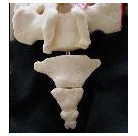A “bone scan” is a test performed by the nuclear medicine part of a radiology center.
A “Nuclear Medicine Bone Scan” is generally considered to be very good for detecting bone destruction from things like bone cancer (malignancy), bone infection (osteomyelitis), or bone injuries (such as fractures).
If the bone scan is truly being done to look for tailbone pain (coccyx pain), you must make sure that the bone scan actually includes the tailbone (coccyx)!
- Many doctors are not aware that a standard Nuclear Medicine Bone Scan does NOT include views of the tailbone.
- In the standard way that a Nuclear Medicine Bone Scan is done, the images are done with a view from the front or the back, but not with a view from the side. Those standard front or back images unfortunately cause the view of the tailbone and lower sacrum to be BLOCKED (obstructed) by the nuclear medicine material in the urinary bladder at the front of the pelvis.
- (Bone scans use nuclear medicine material that lights up bony fractures, tumors, etc. This nuclear medicine material is given intravenously through the IV, then filtered by the kidneys and it collects in the urine within the urinary bladder at the front of the pelvis, where it typically blocks the view of the tailbone. It’s sort of like the nuclear material in the urinary bladder causes a “shadow” blocking out the ability to see what is going on at the tailbone. )
- Thus, the standard technique for a Nuclear Medicine Bone Scan will show a clear picture of ESSENTIALLY the entire body… EXCEPT for the coccyx and lower sacrum.
- Thus, the doctor may order the Nuclear Medicine Bone Scan to check for a cancer at the sacrum or coccyx, but then the test will show essentially the entire body EXCEPT for the area that the patient and doctor are interested in!!
- I have unfortunately seen MANY patients who previously had a bone scan done were tailbone problems, only to be told that it was normal, and then many months later when they come for a consult with me we realize that the bone scan never even included any views showing the tailbone at all!! It’s absolutely crazy, but it happens very often.
- The result is that the doctor and patient think that a Nuclear Medicine Bone Scan has done a good job of making sure there was no cancer or infection at the coccyx, when in reality the bone scan failed to look at that area. So maybe there actually is a cancer or infection there but the Nuclear Medicine Bone Scan missed it.
- The way to avoid this problem is for the doctor to explicitly order the Nuclear Medicine Bone Scan to include images of the pelvis/sacrum/coccyx FROM THE SIDE VIEW, instead of just the front and back views.
- The medical phrase for this side view is a “lateral view”.
- The doctor and patient can explicitly request that the radiology center include side-views (lateral views).
- If you already had a Nuclear Medicine Bone Scan done, then there are some important steps to take…
- Obtain a paper copy of the Nuclear Medicine Bone Scan official, typed radiology report. Read the report and confirm whether the radiologist actually commented explicitly on the appearance of the tailbone. Look for the words coccyx, coccygeal, or sacrococcygeal. If the report fails to specifically mention the appearance of the coccyx, coccygeal, or sacrococcygeal areas, then there is a high likelihood that those areas were not properly seen or included in the images that were done.
- Also obtain an electronic copy of the actual bone scan images (typically on a computer CD) and ask your treating physician to specifically point to the tailbone on the images. Often, the doctor will be surprised to realize that the tailbone was not included at all!
Founder and Director at The Tailbone Pain Center
Latest posts by Patrick Foye, M.D. (see all)
- Coccygectomy: Expected Recovery and Return to Work after surgery for coccyx pain, tailbone pain. - November 28, 2023
- PRP Platelet Rich Plasma or Prolotherapy for Tailbone Pain, Coccyx Pain - October 25, 2023
- Reasons for Normal X-rays and MRI Despite Tailbone Pain, Coccyx Pain - October 3, 2023

